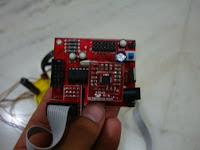


The crux of our paper is to design a feasible method for the locomotion of the people
affected by the disease called QUADRIPLEGIA. The field, robotics has drawn our mutual interest
and it is because of this field we were both able to think of such an idea. Within this enormous
subject there is a classification of robots which are known as autonomous robots. These are
machines which are capable of performing the task without any human intervention. The whole
system here has a brain of its own and it can take particular feed back from the environment and
act according to the circumstances. This kind of an efficient closed loop feedback system is pretty
difficult to fabricate, the errors involved are numerous. However, with a little knowledge from a
workshop in the IIT(Bombay) we were able to think of a prototype and work on it as of now. The
wheelchair we are proposing is almost autonomous. It just requires a mere bend of the neck form
the affected patient in order to activate and perform the task according to the signals generated
by the accelerometer which is the major component of this wheelchair, the fact that an
accelerometer can be used as a sensor which has the capability to measure and generate signals
according to the tilt it is given is considered in this paper. Quadriplegia is a condition in which the
victims have lost sensation and mobility in their both lower and upper parts of the body. As it
affects all the four extremities, this condition can also be called as TETRAPLEGIA. The
accelerometer used is AS7260KB31003. It is fixed in the neck of the quadriplegia patient. The
angle of the neck movement is measured and transmitted to the microcontroller. The
microcontroller has an inbuilt ADC which converts the analog output voltage of the accelerator to
digital signal. For every angle, the microcontroller is programmed to perform certain specific
operations. The DC motor is fixed to the wheel chair. Based on the signal from the microcontroller,
the wheel chair moves in four directions namely, forward, reverse, left, right. An IR sensor is also
fixed to the wheel chair in order to avoid accidents with the obstacles it meets in its way during
locomotion.
The photos shown are the photos of the mother board, the main sensor(accelerometer) and the complete prototype.
By,
Harini Sekar & Kunal Bajaj
hii kunal
ReplyDeletei read your blog
your article Neck movement operated wheel chair for People affected with Quadriplegia. is very interesting and i am doing a project very similar to yours..........
i surfed through many websites but couldn collect enough materials..
i will be very thank full to you if you can send me the circuits and materials...
i have just 55 days to complete this projet n you can help us to make it happen..
pankaj sharma I
final year eee
mepco schlenk engineering college
sivakasi